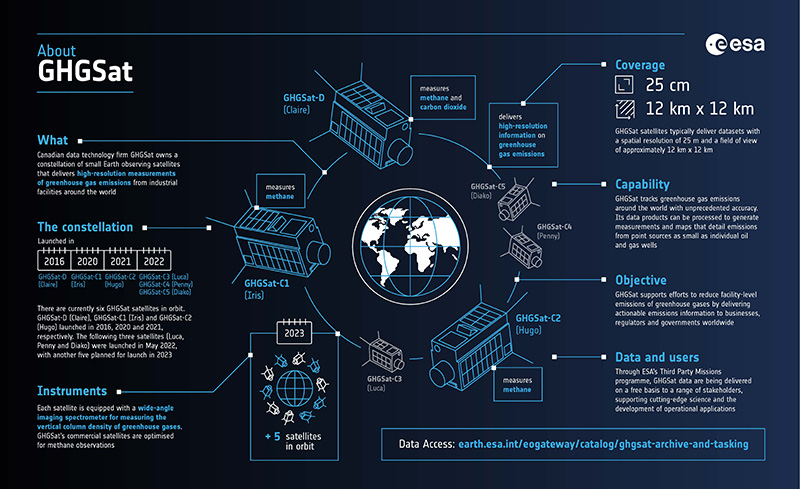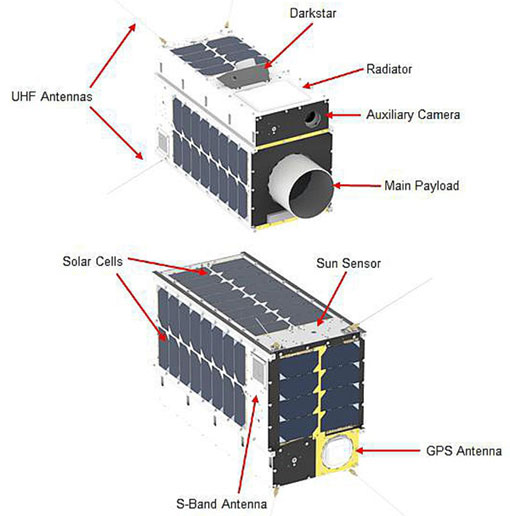- GHGSat
- Mission
- GHGSat Overview
GHGSat Overview
Mission Background
GHGSat is concerned with the remote sensing, identification, and facility attribution of greenhouse gas (GHG) emissions from global sources. The mission is specifically designed for detecting and quantifying GHG emissions from point sources as small as individual oil and gas wells. The GHGSat constellation currently consists of nine satellites: GHGSat-D (GHGSat's technology demonstrator satellite) launched in June 2016, and a commercial fleet, GHGSAT-C1 to GHGSAT-C11, launched from 2020 to 2023, including one (C-10) with a CO2 instrument. GHGSat, as of December 2023, has 12 operational satellites and has already committed 4 more (C-12 to C-15) in 2024, bringing the constellation to 16 units.
GHGSat's current mission is focused on the detection of methane emissions from anthropogenic sources onshore and offshore (with a primary focus on oil & gas, mining, waste management, and agriculture) to provide actionable insights for carbon-intensive industries to mitigate their emissions. Methane is a greenhouse gas, over 80 times more impactful to global heating than carbon dioxide over a 20-year period, making methane reduction critical to achieving climate change goals. Through the Global Methane Pledge, over 100 countries at COP27 committed to reducing methane emissions by 30% by the year 2030. With GHGSat's high resolution, global coverage, and near-daily revisit frequency, it is possible to identify fugitive emissions and track ongoing emissions, providing this data to industry, academia, and governments to make informed operational and policy decisions. In 2022, this resulted in over 500,000 potentially emitting sites being observed over 2 million km2 of land from which 179 MTCO2e of methane emissions were detected.
The data from GHGSat's satellite constellation is complemented by aircraft-based methane measurements (GHGSat-AV) used for even higher resolution and lower detection threshold measurements in targeted areas with a high density of sites and methane retrievals from Sentinel-5P and Sentinel-2 that provide increased temporal coverage for emissions monitoring and support intelligent tasking of the GHGSat constellation.
GHGSat Infographic
See an overview of the GHGSat mission in this infographic:

Satellite Design
GHGSat's satellites are equipped with a wide-angle Fabry-Perot imaging spectrometer designed to measure the vertical column abundances of greenhouse gases. GHGSat-D is capable of measuring both methane and carbon dioxide, while GHGSat's commercial fleet (GHGSat-Cx) is currently optimised for methane, with plans for a carbon dioxide dedicated satellite in 2023. The satellites are three-axis stabilised and are not equipped with a propulsion system. Despite not having a propulsion system, GHGSat is commited to ensuring a safe and sustainable orbital environment and is able to perform collision avoidance maneuvers with the use of differential drag.

| GHGSat-D | GHGSat-Cx | |
| Mass | 15 kg | 16 kg |
| Dimensions | 20×20×42 cm | 20×30×40 cm |
| Design Life | 4 years minimum | 4 years minimum |
| Status | Launched 2016, currently in orbit | Launched between 2020 and present, currently in orbit |
Mission Operations
GHGSat offers satellite imagery and data for measuring methane emissions from targeted industrial facilities anywhere in the world. This imagery and data are collected using a hyperspectral imaging spectrometer operating in a narrow band of the short-wave infrared (SWIR) region of the electromagnetic spectrum. This sensor has both (i) very high spatial resolution (~25 m), and (ii) very high spectral resolution (~0.3 nm), to enable high-precision measurement of vertical column densities of methane in several hundred thousand pixels within the instrument field-of-view. GHGSat's sensor is designed to provide a measurement of the excess methane concentration due to local sources with respect to the surrounding background within a given 12 km x 12 km scene.
The GHGSat constellation of satellites operates in sun-synchronous Low Earth Orbit (LEO) with a period of 95 minutes at altitudes around 500 km. The sun-synchronous orbit of each satellite ensures that observations are collected during daylight (a requirement given that measurements are based on absorbed reflected sunlight) at a consistent time of day for each site.
The constellation is tasked on a daily basis to ensure that the target planning is based on the most recent predicted cloud coverage data. GHGSat's scheduling algorithm prioritizes which sites should be observed based on probability of good weather, historical emission analytics for the site, and emission risk analysis derived from other emission-sensing systems such as Sentinel-5P and Sentinel-2. Targeting is optimized by the algorithm across the constellation to maximize coverage and site revisit.
Related Links
*The information provided is sourced and updated by external entities. For further details, please consult our Terms and Conditions page.